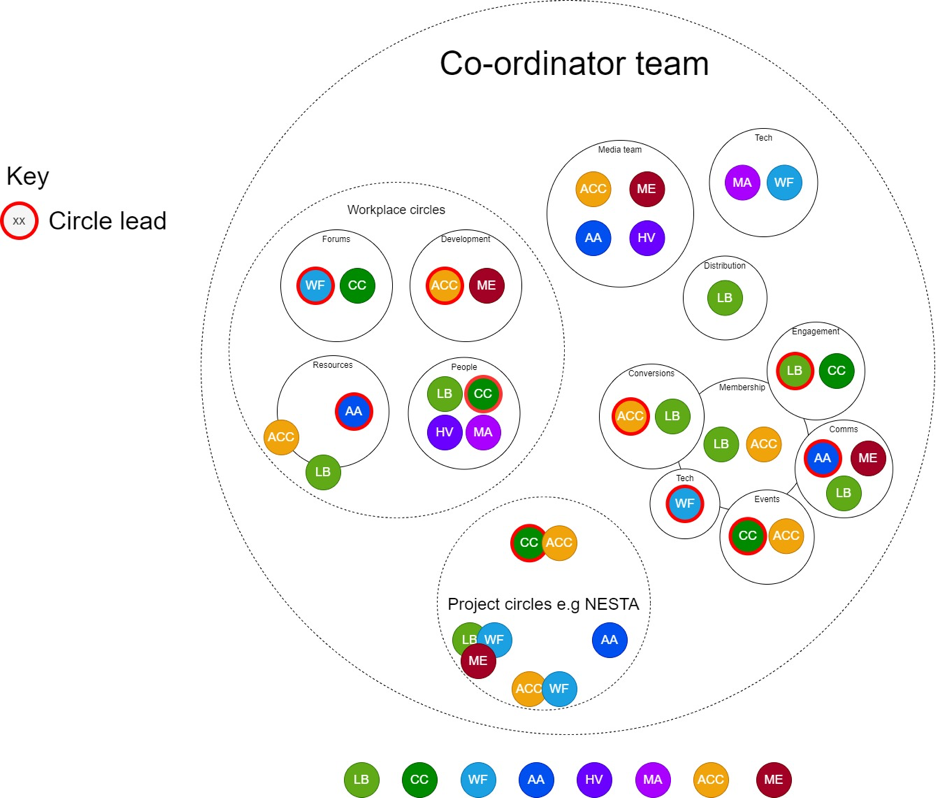Newsroom overview
A grassroots, community-led cooperative covering the U.K. city of Bristol
Bristol, U.K.
2014
2014
50,000
2,200
37 percent
In an effort to avoid a hierarchical structure that would run counter to its cooperative model, The Bristol Cable’s people and teams are organized using a circular staffing model.
Areas of strategy/responsibility are organized as circles, and each circle may contain sub-circles to add increasing levels of specificity. For example, the Cable’s Membership circle is broken down into the sub-circles of Conversion, Engagement, Events, Membership Tech, and Communications. Over the last year, this model has allowed their small team to more effectively allocate and execute membership work, while common connections across circles ensure the work does not become siloed.
Why this is important
The Bristol Cable’s experimentation with this model can be instructive for small and medium sized newsrooms that are unable to hire specific membership staffers. It is one way to both distribute membership work across multiple departments, and ensure clear lines of responsibility and authority.
What they did
The Cable’s circular circular staffing model is grounded in the theory of sociocracy – a governance system based on the principle of equality between organizational members. As a cooperative, the Bristol Cable has operated in line with many principles of sociocracy since its inception in 2014, but it formalized its adoption into its staffing model in 2019.
Cable co-founder Adam Cantwell-Corn and membership and distribution lead Lucas Batt said the model is well suited to helping their small team effectively prioritize and execute on membership strategy.
The Cable’s members are also its co-owners, meaning membership is central to the organization’s business model, and inextricable from its survival. But Cantwell-Corn said this can mean membership becomes “collapsed in on itself… [an] unmanageable mass of work.”
“The principle is to create the necessary space and autonomy and barriers between different groups so [membership] doesn’t become this amorphous thing, but also act on the principle of cross functional teams,” he explained.
The staffing model has six parent circles, which are Workplace, Media, Tech, Distribution, Projects (for managing grant-funded initiatives and specific large and time limited pieces of work that involve two or more Circles), and Membership. Membership is a “parent circle,” led by Cantwell-Corn and Batt. As leaders of the parent circle, they work to define the ownership and key responsibility areas for each membership sub-circle, and ensure the sub-circles are communicating with one another.
The membership sub-circles are arranged as follows:
Communication
Circle lead: Alon Aviram (Co-founder)
Circle members: Lucas Batt (Membership & Distribution), Matty Edwards (Reporter)
Areas of responsibility: Branding, PR, members communications, newsletters
Conversion
Circle lead: Adam Cantwell-Corn (Co-founder)
Circle members: Lucas Batt (Membership & Distribution)
Area of ownership: Audience funnel, audience development, metrics & target setting, gift memberships, referral scheme, retention
Membership Tech
Circle lead: Will Franklin (Tech Coordinator) and various others dependant on need
Areas of ownership: Website maintenance, website redevelopment, development of membership system and CRM
Engagement
Circle lead: Lucas Batt (Membership & Distribution)
Circle members: Cait Crosse (Community & Events Organizer)
Areas of ownership: online engagement, member relationships, member experience
Events
Circle lead: Cait Crosse (Community & Events Organizer)
Circle members: Adam Cantwell-Corn (Co-founder)
Areas of ownership: Events and community partnerships

Each sub-circle lead convenes and manages that group, and coordinates with other sub-circle leads as needed.
One of the key features of the model is the connections created by staff members being in more than one circle – known in sociocracy as a “double link.” Batt, for example, features in the Communications, Engagement, and Conversion circles. “That has a multiplying effect – a way of spreading information and aligning the goals of these groups,” he said.
Each sub-circle sets its own working practices for day-to-day task management, but will frequently collaborate with other circles via working groups for specific time bound projects.
The results
Cantwell-Corn and Batt said their circular model has led to membership work being broken down more effectively – with clear lines of responsibility – but without it becoming siloed. As a small team, it has also allowed them to be agile when trying to deal with the skills gaps in their organization.
“We’re trying to plug gaps and holes, rather than having a suite of people and skills that absolutely fit in terms of capacity and experience,” Batt said.
When the team wanted to launch its new community engagement tool, Cable Links, the Engagement sub-circle took the lead. They were responsible for the vision and management of the project. But they relied heavily on the Membership Tech sub-circle (as well as a third party design agency to create the technical infrastructure and implement it. A temporary working group was set up to convene the two circles and move the project forward. Gift memberships were initiated by the Conversion circle, but Membership Tech developed the functionality and Comms promoted the finished product.
What they learned
Be crystal clear about each circle’s brief. Batt believes a review of the brief for each circle is needed in future to make them clearer and identify where the overlaps are. He also thinks the Cable needs to clarify when and why people need to meet between circles, and further improvements could be made to the rhythms connecting membership and editorial.
Cantwell-Corn said they also want to strengthen the processes by which everyone in the organization is pulling in the same direction for a certain period of time. They’ve recently introduced quarterly organizational sprints to try and facilitate this.
High demand and limited capacity mean sacrifices still have to be made. While this staffing model has helped to improve connections across the organization – and to place membership front-and-center for everyone – capacity is still a problem in a newsroom with 10 staff. The fact that people exist in multiple circles means “if there’s demand here, we take capacity from there.” Cantwell-Corn said: “It’s hard sometimes [to work out] whether things aren’t working because the structure isn’t right, or because of practicalities with regards to capacity or the application of skills and experience.”
Consider the imbalance between sub-circles. Another weakness of the structure right now is that the powers of initiation are uneven between sub-circles. The Conversion sub-circle, for example, currently has responsibility for much of the core work around membership product and growth. “Other circles are a little bit in service of that… There’s more agency sitting with conversion,” Cantwell-Corn said.
Key takeaways and cautionary notes
A circular staffing model can help small and medium-sized newsrooms with limited resources to organize membership work, set clear lines of responsibility, and facilitate cross functional working.
This model may not iron out all workload imbalances between teams involved in membership, and careful consideration needs to be given to how involvement in multiple circles will impact each staff member’s capacity.
Other resources
- Harry Kaloudis, Medium: A very brief introduction to sociocracy
- Alon Aviram, journalism.co.uk: The Bristol Cable launches new tool to engage readers with local journalism


